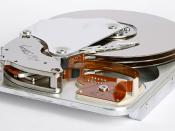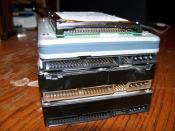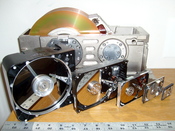Magnetic Marvels
The hard-disk drive is a wonder of modern technology, consisting of a stack of disk platters, each one an aluminum alloy or glass substrate coated with a magnetic material and protective layers. Read-write heads, typically located on both sides of each platter, record and retrieve data from circumferential tracks on the magnetic medium. Servomechanical actuator arms position the heads precisely above the tracks, and a hydrodynamic air bearing is used to "fly" the heads above the surface at heights measured in fractions of microinches. A spindle motor rotates the stack at speeds of between 3,600 and 10,000 revolutions per minute. This basic design traces its origins to the first hard-disk drive--the Random
ADDING OPTICAL TO MAGNETIC
Various innovations have led to dramatic increases in storage capacity and equally amazing decreases in the physical dimensions of the drives themselves. Indeed, storage capacity has jumped multiple orders of magnitude during that time, with the result that some of today's desktop PCs have disk drives containing more than 70 gigabytes.
Tom H. Porter, chief technology officer at California-based Seagate Technology's Minneapolis office, explains that the industry has achieved these improvements largely through straightforward miniaturization. "Smaller heads, thinner disks, smaller fly heights [the distance between head and platter]: everything has been about scaling," he notes.
Head Improvements
Many of the past improvements in disk-drive capacity have been a result of advances in the read-write head, which records data by altering the magnetic polarities of tiny areas, called domains (each domain representing one bit), in the storage medium. To retrieve that information, the head is positioned so that the magnetic states of the domains produce an electrical signal that can be interpreted as a string of 0's and 1's. Early products used heads made of ferrite, but beginning in 1979 silicon chip-building technology...



Nice... So far
I liked how its shaping up, but it doesn't look complete... I think you could go into more detail in certain areas...
4 out of 4 people found this comment useful.